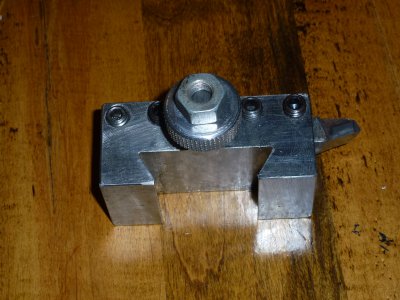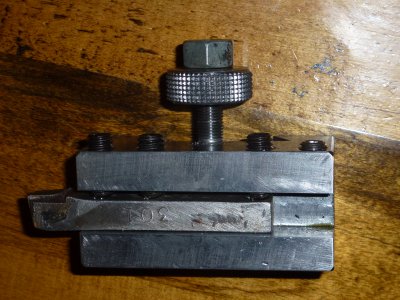- Joined
- Feb 7, 2013
- Messages
- 2,485
A friend of mine gave me a box of various tool steel leftovers from the tool and die shop where he worked. There
were several pieces of P20 tool steel just the right size for making tool holders for my C size Aloris tool post.
I did the milling with carbide cutters since it was somewhat hard material to machine. The 60 degree angles
were cut using a home made cutter made with a pair of triangular carbides. The interesting part came when
tapping the holes in the holder. It was tough going and broke off a tap in a hole that I had to drill out with
carbide. Other than that it went pretty well. Over the years I have made at least a dozen tool holders, all
of mild steel, which by the way have held up just fine for my use. So that's the story on P20 steel. In it's
unhardened condition, it has a Rockwell hardness of 30 to 32 which is where it can stay for this application.
It was a fun few hours in the shop making chips and turning a raw chunk into something useful.

I used a diamond flat lap to get some of the machining evidence to go away. Maybe sometime when I'm completely bored, I will go over it again
but for now it is good enough.
were several pieces of P20 tool steel just the right size for making tool holders for my C size Aloris tool post.
I did the milling with carbide cutters since it was somewhat hard material to machine. The 60 degree angles
were cut using a home made cutter made with a pair of triangular carbides. The interesting part came when
tapping the holes in the holder. It was tough going and broke off a tap in a hole that I had to drill out with
carbide. Other than that it went pretty well. Over the years I have made at least a dozen tool holders, all
of mild steel, which by the way have held up just fine for my use. So that's the story on P20 steel. In it's
unhardened condition, it has a Rockwell hardness of 30 to 32 which is where it can stay for this application.
It was a fun few hours in the shop making chips and turning a raw chunk into something useful.


I used a diamond flat lap to get some of the machining evidence to go away. Maybe sometime when I'm completely bored, I will go over it again
but for now it is good enough.

